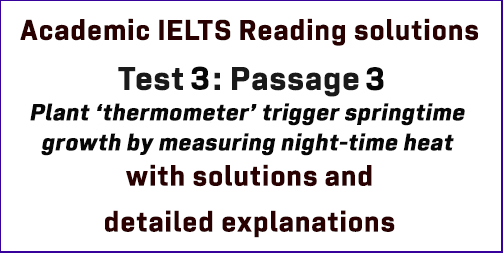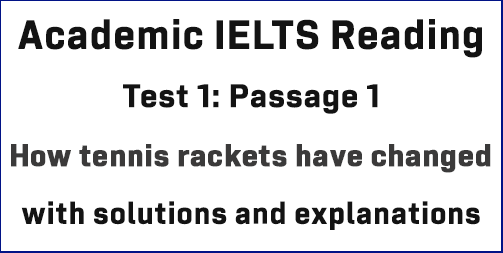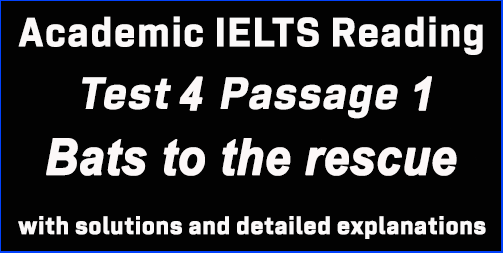Academic IELTS Reading: Test 3 Reading passage 3; Plant ‘thermometer’ triggers springtime growth by measuring night-time heat; with best solutions and explanations
This Academic IELTS Reading post focuses on solutions to IELTS Reading Test 3 Reading Passage 3 entitled ‘Plant ‘thermometer’ triggers springtime growth by measuring night-time heat’. This is an aimed post for IELTS candidates who have big problems finding out and understanding Reading Answers in the AC module. This post can guide you to the best to understand every Reading answer without much trouble. Finding out IELTS Reading answers is a steady process, and this post will assist you in this respect.
Test 3: AC Reading Module
Reading Passage 3: Questions 27-40
The headline of the passage: Plant ‘thermometer’ triggers springtime growth by measuring night-time heat
Questions 27-32: TRUE, FALSE, NOT GIVEN
[In this type of question, candidates are asked to find out whether:
The statement in the question agrees with the information in the passage – TRUE
The statement in the question contradicts the information in the passage – FALSE
If there is no information on this – NOT GIVEN
For this type of question, you can divide each statement into three independent pieces and make your way through with the answer.]
Question no. 27: The Cambridge scientists’ discovery of the ‘thermometer molecule’ caused surprise among other scientists.
Keywords for the question: Cambridge scientists’ discovery, ‘thermometer molecule’, caused surprise, other scientists,
We find a reference to the discovery of the ‘thermometer molecule’ made by the Cambridge scientists in section A, at the very beginning. However, there is NO MENTION of whether it surprised other scientists or not in this passage.
So, the answer is: NOT GIVEN
Question no. 28: The target for agricultural production by 2050 could be missed.
Keywords for the question: target, agricultural production, by 2050, could be missed,
The answer to this question can be traced in lines 4-5 of section D. The writer says here, “ . . .. .. ‘It is estimated that agricultural yields will need to double by 2050, but climate change is a major threat to achieving this. . .. .”
Here, agricultural yields = agricultural production, climate change is a major threat to achieving this = the target . .. could be missed,
So, the answer is: TRUE
Question no. 29: Wheat and rice suffer from a rise in temperatures.
Keywords for the question: wheat and rice, suffer from, rise in temperature,
Again, in section D, lines 5-6 say, “ . .. . . Key crops such as wheat and rice are sensitive to high temperatures. .. .. .”
Here, sensitive to high temperatures = suffer from a rise in temperatures,
So, the answer is: TRUE
Question no. 30: It may be possible to develop crops that require less water.
Keywords for the question: may be possible, develop, crops, require, less water,
There is NO INFORMATION in this passage regarding the possibility of developing crops that require less water.
So, the answer is: NOT GIVEN
Question no. 31: Plants grow faster in sunlight than in shade.
Keywords for the question: plants, grow faster, sunlight, than, shade,
Take a close look at these lines from section E, “ . .. . During the day, sunlight activates the molecules, slowing down growth. If a plant finds itself in shade, phytochromes are quickly inactivated – enabling it to grow faster to find sunlight again. . . … ..”
Here, the lines clearly point out that plants grow faster in shade than in sunlight.
So, the answer is: FALSE
Question no. 32: Phytochromes change their state at the same speed day and night.
Keywords for the question: phytochromes, change, state, same speed, day and night,
The answer lies in the last lines of the first paragraph and the first lines of the second paragraph in section E.
First, take a look at the last lines of the first paragraph, “ . . .. . ‘Light-driven changes to phytochrome activity occur very fast, in less than a second,’ says Wigge.”
These lines suggest that phytochromes change their state very fast during the day.
Then, take a look at the first lines of the second paragraph, “At night, however, it’s a different story. Instead of a rapid deactivation following sundown, the molecules gradually change from their active to inactive state. .. ..”
Here, gradually change = change their state slowly,
These lines suggest that phytochromes change their state slowly at night.
So, the answer is: FALSE
Questions 33-37: Identifying information
[This question asks you to find information from the passage and write the number of the paragraph (A, B, C or D … .. ) in the answer sheet. Now, if the question is given in the very first part of the question set, I’d request you not to answer them. It’s mainly because this question will not follow any sequence, and so it will surely kill your time. Rather, you should answer all the other questions first. And just like the List of Headings, only read the first two lines or the last two lines of the expected paragraph initially. If you find the answers, you need not read the middle part. If you don’t find answers yet, you can skim the middle part of the paragraph. Keywords will be a useful matter here.]
Question no. 33: mention of specialists who can make use of the research findings
Keywords for the question: specialists, make use of, research findings,
In the final few lines of section H, the writer says, “ . . .. ‘Cambridge is uniquely well-positioned to do this kind of research as we have outstanding collaborators nearby who work on more applied aspects of plant biology, and can help us transfer this new knowledge into the field.’”
Here, outstanding collaborators = specialists, can help us transfer this new knowledge into the field = can make use of the research findings,
So, the answer is: H
Question no. 34: a reference to a potential benefit of the research findings
Keywords for the question: potential benefit, research findings,
To find the answer to this question, we have to read lines 1-3 of section D, “With weather and temperatures set to become ever more unpredictable due to climate change, researchers say the discovery that this light-sensing molecule also functions as the internal thermometer in plant cells could help us breed tougher crops. . .. .”
Here, the discovery = the research findings, could help us breed tougher crops = a potential benefit,
So, the answer is: D
Question no. 35: scientific support for a traditional saying
Keywords for the question: scientific support, traditional saying,
Section G contains two paragraphs.
In paragraph no. 1, the author of the passage says in lines 3-5, “ . . .. . In fact, the discovery of the dual role of phytochromes provides the science behind a well-known rhyme long used to predict the coming season: oak before ash we’ll have a splash, ash before oak we’re in for a soak.”
Here, the science behind a well-known rhyme long used to predict the coming season = scientific support for a traditional saying,
So, the answer is: G
Question no. 36: a reference to people traditionally making plans based on plant behaviour
Keywords for the question: people, traditionally, making plans, plant behaviour,
In the first lines of section C, the author says, “Farmers and gardeners have known for hundreds of years how responsive plants are to temperature: warm winters cause many trees and flowers to bud early, something humans have long used to predict weather and harvest times for the coming year. … ..”
Here, humans have long used to predict weather and harvest times for the coming year = people traditionally making plans, how responsive plants are to temperature = plant behaviour,
So, the answer is: C
Question no. 37: a reference to where the research has been reported
Keywords for the question: where, research, reported,
In section A, we find two paragraphs.
In the second paragraph, the writer explains, “The new findings, published in the journal Science, . . .. .”
Here, new findings = the research, published in the journal Science = has been reported,
So, the answer is: A
Questions 38-40: Completing sentences with NO MORE THAN TWO WORDS
In this type of question, candidates are asked to write a maximum of two words to complete sentences on the given topic. For this type of question, first, skim the passage to find the keywords in the paragraph concerned with the answer, and then scan to find the exact word.
[TIPS: Here scanning technique will come in handy. Target the keywords of the questions to find the answers. Remember to focus on Proper nouns, random Capital letters, numbers, special characters of text, etc.]
Question no. 38: Daffodils are likely to flower early in response to _______ weather.
Keywords for the question: Daffodils, likely to flower, early, weather,
We find a reference to ‘daffodils’ in Section G. Here, in the first paragraph, the writer says, “Some plants mainly use day length as an indicator of the season. Other species, such as daffodils, have considerable temperature sensitivity, and can flower months in advance during a warm winter. .. . .. .”
Here, can flower months in advance = are likely to flower early,
So, the answer is: warm (winter)
Question no. 39: If ash trees come into leaf before oak trees, the weather in _______ will probably be wet.
Keywords for the question: if, ash trees, come into leaf, before oak trees, weather, will probably, be wet,
Again, in section G, take a close look at the second paragraph. Here, in lines 3-6, the writer explains, “ … . .. . A warmer spring, and consequently a higher likeliness of a hot summer, will result in oak leafing before ash. A cold spring will see the opposite. As the British know only too well, a colder summer is likely to be a rain-soaked one.. .. . .”
Here, the opposite = ash trees come into leaf before oak trees, likely to be a rain-soaked one = probably be wet,
So, the answer is: summer
Question no. 40: The research was carried out using a particular species of _________.
Keywords for the question: research, carried out, using, particular species,
The answer can be found in the first few lines of section H. The writer says here, “The new findings are the culmination of twelve years of research involving scientists from Germany, Argentina, the US, as well as the Cambridge team. The work was done in a model system, using a mustard plant called Arabidopsis. .. .. .”
Here, twelve years of research = the research,
So, the answer is: mustard plant(s) / mustard
Click here for solutions to Test 3 Passage 1: Roman shipbuilding and navigation



